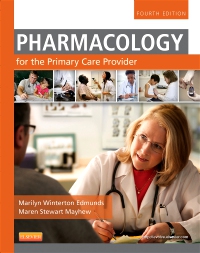
Pharmacology for the Primary Care Provider - Elsevier eBook on VitalSource, 4th Edition
Elsevier eBook on VitalSource

Written by and for nurse practitioners, and also suited for physician’s assistants, Pharmacology for the Primary Care Provider, 4th Edition focuses on what students and practitioners need to know to safely and effectively prescribe drugs for primary care. An emphasis on patient teaching helps in gaining patient adherence to prescribed drug regimens, and guidelines for health promotion help in maintaining and improving patients’ health. Now in full color, this edition expands the book's emphasis on the QSEN priorities of safety and evidence-based practice, and adds coverage of new drugs, new drug classes, and new therapeutic drug uses. This practical text teaches the principles of pharmacotherapeutics using today’s most commonly used drugs.
Newer Edition Available
Edmunds' Pharmacology for the Primary Care Provider - Elsevier eBook on VitalSource
-
- NEW! Full-color design and illustrations highlight the most important content.
- DRUG UPDATES reflect the latest FDA-approved drugs, drug classes, and therapeutic uses.
- Expanded emphasis on the QSEN priorities of safety and evidence-based practice helps to eliminate drug prescribing errors with color-highlighted Safety Alerts! and NEW Clinical Practice Alerts
- NEW section on male hormone replacement therapies adds coverage of men to that for women.
- Updated evidence-based prescribing information reflects the latest national clinical practice guidelines and evidence-based treatment guidelines, including the latest clinical treatment guidelines for diabetes.
- NEW! Complementary and Alternative Products tables highlight interactions with drugs, and are emphasized with a distinctive icon.
- Updated Drug Overview tables are enhanced with color as well as Top 100 icons that highlight the most commonly prescribed drugs.
- A Key Drugs focus highlights the most commonly used and most representative drugs of each major drug class — with particular emphasis on the top 100 most commonly prescribed drugs.
- Emphasis on patient teaching helps in communicating with patients and family caregivers to promote adherence to the drug regimen.
- Emphasis on health promotion describes how to help patients stay well and improve their health, including coverage of immunizations and biologicals, vitamins, weight management, and smoking cessation.
- Evidence-Based Decision-Making and Treatment Guidelines chapter (11) provides practical guidelines for using the best current research evidence to make decisions about the care of individual patients.
- Extensive coverage of drug therapy for special populations such as geriatric and pediatric patients includes considerations related to age, pregnancy, race, and other factors.
- UNIQUE! Coverage of prescriptive practice includes topics such as prescriptive authority, role implementation, and the role of nurses (NPs, CNMs, CRNAs, and CNSs) and physician assistants in writing prescriptions.
-
- NEW! Full-color design and illustrations highlight the most important content.
- DRUG UPDATES reflect the latest FDA-approved drugs, drug classes, and therapeutic uses.
- Expanded emphasis on the QSEN priorities of safety and evidence-based practice helps you eliminate drug prescribing errors with color-highlighted Safety Alerts! and NEW Clinical Practice Alerts!
- NEW section on male hormone replacement therapies adds coverage of men to that for women.
- Updated evidence-based prescribing information reflects the latest national clinical practice guidelines and evidence-based treatment guidelines, including the latest clinical treatment guidelines for diabetes.
- NEW! Complementary and Alternative Products tables highlight interactions with drugs, and are emphasized with a distinctive icon.
- Updated Drug Overview tables are enhanced with color as well as Top 100 icons that highlight the most commonly prescribed drugs.
-
PART ONE: ESSENTIAL CONCEPTS FOR THE PRESCRIPTION OF MEDICATIONS
Unit 1: Foundations of Prescriptive Practice
1. Prescriptive Authority and Role Implementation: Tradition vs. Change
2. Historical Review of Prescriptive Authority: The Role of Nurses (NPs, CNMs, CRNAs, and CNSs) and Physician AssistantsUnit 2: Pharmacokinetics and Pharmacodynamics
3. General Pharmacokinetic and Pharmacodynamic Principles
4. Special Populations: Geriatrics
5. Special Populations: Pediatrics
6. Special Populations: Pregnant and Nursing Women7. Over-the-Counter Medications
8. Complementary and Alternative TherapiesUnit 3: The Art and Science of Pharmacotherapeutics
9. Establishing the Therapeutic Relationship
10. Practical Tips on Writing Prescriptions
11. Evidence-Based Decision-Making and Treatment Guidelines
12. Design and Implementation of Patient EducationPART TWO: DRUG MONOGRAPHS
Unit 4: Topical Agents
13. Dermatologic Agents
14. Eye, Ear, Throat, and Mouth AgentsUnit 5: Respiratory Agents
15. Upper Respiratory Agents
16. Asthma and Chronic Obstructive Pulmonary Disease MedicationsUnit 6: Cardiovascular Agents
17. Hypertension and Miscellaneous Antihypertensive Medications
18. Coronary Artery Disease and Antianginal Medications
19. Heart Failure and Digoxin
20. β-Blockers
21. Calcium Channel Blockers
22. ACE Inhibitors and Angiotensin Receptor Blockers
23. Antiarrhythmic Agents
24. Antihyperlipidemic Agents
25. Agents that Act on BloodUnit 7: Gastrointestinal Agents
26. Antacids and the Management of GERD
27. Histamine-2 Blockers and Proton Pump Inhibitors
28. Laxatives
29. Antidiarrheals
30. Antiemetics
31. Medications for Irritable Bowel Syndrome and Other Gastrointestinal ProblemsUnit 8: Renal/Genitourinary Agents
32. Diuretics
33. Male Genitourinary Agents
34. Drugs for Urinary Incontinence and Urinary AnalgesiaUnit 9: Musculoskeletal Agents
35. Acetaminophen
36. Aspirin and Nonsteroidal Antiinflammatory Drugs
37. Disease-Modifying Antirheumatic Drugs and Immune Modulators
38. Gout Medications
39. Osteoporosis Treatment
40. Muscle RelaxantsUnit 10: Central Nervous System Agents
41. Medications for Attention Deficit Hyperactivity Disorder
42. Medications for Dementia
43. Analgesia and Pain Management
44. Migraine Medications
45. Antiepileptics
46. Antiparkinson AgentsUnit 11: Psychotropic Agents
47. Antidepressants
48. Antianxiety and Antiinsomnia Agents
49. Antipsychotics
50. Substance AbuseUnit 12: Endocrine Agents
52. Glucocorticoids
52. Thyroid Medications
53. Diabetes Mellitus AgentsUnit 13: Reproductive System Medications
54. Contraceptives
55. Hormone Replacement Therapy – NEW Title/Focus!
56. Drugs for Breast CancerUnit 14: Antiinfectives
57. Principles for Prescribing Antiinfectives
58. Treatment of Specific Infections and Miscellaneous Antibiotics
59. Penicillins
60. Cephalosporins
61. Tetracyclines
62. Macrolides
63. Fluoroquinolones
64. Aminoglycosides
65. Sulfonamides
66. Antitubercular Agents
67. Antifungals
68. Antiretroviral Medications
69. Antiviral and Antiprotozoal AgentsUnit 15: Health Promotion
70. Immunizations and Biologicals71. Weight Management
72. Smoking Cessation
73. Vitamins and Minerals


 as described in our
as described in our 